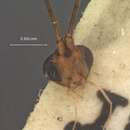Distribution
provided by Catalog of Hymenoptera in America North of Mexico
Md.
- bibliographic citation
- Catalog of Hymenoptera in America North of Mexico. 1979. Prepared cooperatively by specialists on the various groups of Hymenoptera under the direction of Karl V. Krombein and Paul D. Hurd, Jr., Smithsonian Institution, and David R. Smith and B. D. Burks, Systematic Entomology Laboratory, Insect Identification and Beneficial Insect Introduction Institute. Science and Education Administration, United States Department of Agriculture.
Comprehensive Description
provided by Smithsonian Contributions to Zoology
Orgilus tenuis
In habitus and in various details this species is most similar to notabilis, new species. It is immediately distinguishable from notabilis, however, as from all other species of this group of Orgilus I have seen, by its extraordinarily short calcaria of the hind tibia, the inner of which is only one-third as long as the metatarsus.
FEMALE.—Length about 4.2 mm. A very slender species. Head wider than thorax and in dorsal view about twice as broad as long; face not quite as wide as eye height, shagreened and finely punctate; eyes very large; malar space about one-fourth as long as eye height; maxillary palpi long, longer than width of head; anterior tentorial pits on a line with lower eye margins; cheeks shagreened; temples flat, receding sharply from eye margins, finely shagreened; occiput immargined; frons and vertex coriaceous; diameter of lateral ocelli nearly equal to the distance between them and more than half as long as ocellocular line; antennae of the holotype and only known specimen 33-segmented, very slender, even the shortest flagellar segments longer than broad.
Mesoscutum finely granulose and somewhat mat; notauli complete, sharp, weakly foveolate; propodeum evenly convex, uniformly granulose and with short stubs of longitudinal carinae arising from the posterior margin and setting off five apical areas that are open in front; lateral face of pronotum, mesopleuron, and metapleuron completely shagreened and rather dull; the longitudinal mesopleural furrow indicated but very weak. Hind coxa half as long as thorax and three-fourths as long as hind femur, uniformly shagreened; hind femur at least four times as long as broad; inner calcarium of hind tibia only one-third as long as metatarsus; tarsal claws simple. Radial cell on wing margin much longer than stigma (in ratio of 50:38); stigma large and broad, emitting radius from its middle; second abscissa of cubitus less than half as long as recurrent vein; not even a vestige of third abscissa of cubitus present; nervulus interstitial; hind wing about six times as long as wide; lower abscissa of basella more than twice as long as nervellus, more than half as long as mediella and three-fourths as long as maximum width of hind wing.
Abdomen very slender, much narrower than thorax; first tergite more than twice as long as wide at apex, a little rugulose basally and finely granulose apically, the basal dorsal keels distinct but short; second tergite much longer than broad at base or apex, confluently punctate, almost rugulose basally; third tergite very nearly as long as broad at base, also largely confluently punctate but smooth and shining in the apical corners; second suture sharply impressed; fourth and following tergites smooth; ovipositor sheath considerably longer than head, thorax, and abdomen combined.
Brownish black; head in front, including clypeus, mandibles and cheeks, brownish yellow; palpi yellow; antennae pale brown basally, darkened apically; fore-and middle legs yellow, their tibiae and tarsi a little darkened; hind coxae blackish brown, hind trochanters and femora pale, their tibiae and tarsi darkened; tegulae and wing bases testaceous; wings subhyaline; abdomen blackish brown but with the second tergite and the base of the third pale brown.
MALE.—Unknown.
HOLOTYPE.—USNM 70195.
DISTRIBUTION.—Known only from the holotype female collected 9 August 1950, at Patuxent Refuge, Bowie, Maryland, by R. T. Mitchell.
- bibliographic citation
- Muesebeck, Carl F. W. 1970. "The Nearctic species of Orgilus Haliday (Hymenoptera: Braconidae)." Smithsonian Contributions to Zoology. 1-104. https://doi.org/10.5479/si.00810282.30

